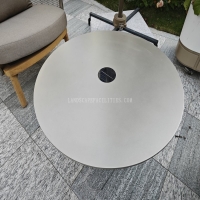Welcome to the website for landscape facilities products and knowledge.
How does the table perform in high-wind conditions, and are there anchoring solutions available?
Outdoor tables face significant challenges during high-wind conditions, with performance largely dependent on design, materials, and proper installation. Modern wind-resistant tables typically feature heavy-duty construction materials like powder-coated aluminum or treated hardwoods that provide inherent stability against gusty conditions. The table's design elements play a crucial role - low-profile models with wider bases and strategically placed cross-braces demonstrate superior wind resistance compared to taller, top-heavy designs.
For enhanced security in windy locations, manufacturers offer various anchoring solutions specifically engineered for different table types and surface materials. Permanent anchoring systems include ground screw anchors that penetrate deep into soil, concrete footings for ultimate stability, and bolt-down kits for hard surfaces like patios and decks. These permanent solutions typically require professional installation but provide unmatched wind resistance during severe weather events.
Semi-permanent options offer flexibility while maintaining security. Weighted base systems allow tables to remain in place during moderate winds while permitting seasonal relocation. Sandbag anchors concealed within decorative covers provide additional ballast without compromising aesthetics. For temporary setups, quick-release anchor kits enable rapid deployment before anticipated storms and easy removal when conditions improve.
The effectiveness of any anchoring system depends on proper installation and regular maintenance. Anchors should be checked seasonally for corrosion or loosening, particularly in coastal environments where salt air accelerates wear. Table placement also impacts wind performance - positioning tables near windbreaks like walls or hedges significantly reduces wind load.
Manufacturers increasingly incorporate wind-resistant features directly into table designs, including perforated tabletops that allow wind passage, weighted legs with adjustable leveling feet, and integrated anchor points for straightforward security system installation. These innovations ensure tables remain stable in winds exceeding 50 mph when properly anchored.
When selecting both tables and anchoring systems, consider local wind patterns, typical weather conditions, and installation surface characteristics. Consulting with landscape professionals can help determine the optimal combination of table design and anchoring method for specific environmental conditions, ensuring your outdoor furniture remains secure through changing seasons and unexpected weather events.
Related search:

Recommendation
Outdoor stainless steel table with solar-powered ambient lighting feature - excellent design.